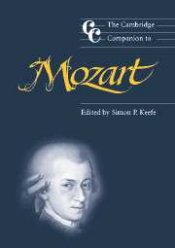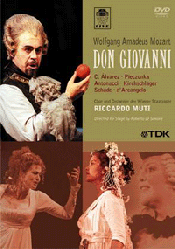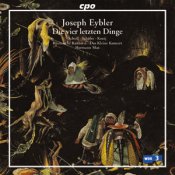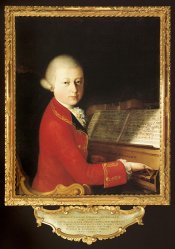How much more do we want to know? How much more do we need to know? The many writings about Mozart since WW II are not of a passing interest. They betray a fascination, almost an obsession, with the life of this 18th century musician. A life that was akin to a great shooting star, which streaked across the musical heavens. As it burned itself out in its course, it delighted and amazed those who saw it and became legend and tale to those who did not, even creating its own band of nay-sayers. Such was the life of “God’s love,” (Theophilus) or as Mozart preferred Amadeus.
The approaching 250th anniversary of the birth of Wolfgang Amadeus Mozart brings to the fore of the music market DVDs, CDs, books, memorabilia and, yes, even kitsch. The following essay offers a look at three items worthy of reading, viewing, and hearing. These are aesthetic and intellectual pleasures for those searching for a “new” and enriching Mozart experience.
 The Cambridge Companion to Mozart. Edited by Simon P. Keefe. Cambridge: Cambridge University Press, first published 2003.
The Cambridge Companion to Mozart. Edited by Simon P. Keefe. Cambridge: Cambridge University Press, first published 2003.
In the world of Mozartiana, fiction is often accepted more as fact than the facts themselves. There is the continuous quest to reveal some titillating new detail about the personal life of the composer, whereby the gossip mills keep turning and the caricature of an eccentric or even an “idiot savant” remains fixed in the mind of those who would have it be so. Fortunately, this book is a publication of scholarly merit, which is as “accessible” to the academic as it is to the enthusiast. The Cambridge Companion to Mozart is must reading.
The first Mozart Companion, subtitled A Symposium by Leading Mozart Scholars, edited by H. C. Robbins Landon and Donald Mitchell, appeared in print in 1955/56 in conjunction with the bicentenary of the composer’s birth. The annotations alone, speak of its place in the nascent stages of Mozart scholarship: the use of Emily Anderson’s translations of The Letters of Mozart and his Family (1938), Koechel’s thematic catalog of Mozart’s works, a third edition prepared by Alfred Einstein in 1937 and further revised after WW II (1947), and the names of such eminent Mozart scholars as Otto Erich Deutsch, Friedrich Blume, H. C. Robbins Landon, Karl Geiringer, Gerald Abraham, and Jens Peter Larsen, each contributing according to his own area of expertise. While the essays and discussions touch on style and influence, the focus is the music: keyboard, wind band, chamber music, symphonies, concerti, operas, concert arias, small orchestral works, and church music. In his “Foreword,” Donald Mitchell writes: “Mozart’s extraordinary versatility, the ease with which he worked in the various media … makes it almost impossible for one commentator … The picture of the whole Mozart is too complex in extent and content … for one mind to comprehend the total unity which exists behind the dazzling variety.” (xi) One might also say that it is too complex for one Companion.
The Cambridge Companion to Mozart is a continuation of the work published fifty years ago, as Simon P. Keefe states, “Like its illustrious predecessor from an earlier era … The Cambridge Companion to Mozart brings new, up-to-date scholarship into a public arena. Intended for scholars and music lovers alike, it aims to bridge the gap between scholarly and popular images of the composer by enhancing a reader’s appreciation of Mozart and his remarkable output regardless of musical aptitude or prior knowledge of Mozart’s music.” (Introduction, 2) The recurring theme in both publications, as well as in Mozartian secondary literature in general, is that the music and the man deserve responsible analysis and interpretation.
Essayists of the first Companion have since become distinguished names in the area of Mozart scholarship: Emily Anderson, whose Letters is now in its third edition; Wilhelm Bauer and Otto Erich Deutsch, authors of the seven volumes of Mozart: Letters and Records; Deutsch’s Mozart: A Documentary Biography and his Mozart: The Documents of his Life; and the exquisite Neue Ausgabe sämtlicher Werke, which began in 1955 and continues today.
The Cambridge Companion is in four parts, offering something to those of all music disciplines: 1) attends to Mozart’s place in late 18th century Salzburg and Vienna, with a new and vigorous discussion of Mozart’s aesthetic views and those of the times, as well as his compositional methods. This section is of particular interest in regards to Mozart’s life in Salzburg, his vocal writing and recent scholarship that addresses the revisions in some of his arias, and his fondness for the voice and for singers. 2) Offers a survey of the genres in which Mozart excelled, although a bit lean when compared to similar sections in the 1955/56 Companion; it segues into part 3) how the music and the composer himself have been received in society and culture since his death. The nineteenth century perspective and the current fascination are discussions, the benefit of which, are the product of time. 4) This section, regrettably too short, addresses Mozart’s career as a performer as well as theoretical and practical perspectives on historically informed performances of his music. By its length and overview approach, it is more of an introduction to the topic. Levin in particular, offers enough commentary to spark interest for those of a serious nature to look further, and for the appetite of the devotee to be sated. Throughout the Companion, the endnotes are rich in content. It is best to read them in connection with the text; the flipping back and forth is well worth the effort.
The definition of the word “companion” (one who accompanies or associates with another; one who travels with another) suggests that this book is not to be read in a vacuum, but rather in conjunction with something else. One might read it in combination with the first Companion, a live performance, or a Mozart listening event. It serves as a wonderful introduction to Mozart opera, Don Giovanni.
 Don Giovanni (K. 527), conducted by Riccardo Muti, with the Chorus and Orchestra of the Vienna Staatsoper; Carlos Álvarez, Fran-Josef Selig, Adrianne, Pieczonka, Michael Schade, Anna Caterina Antonacci, Ildebrando d’Arcangelo, Angelika Kirchschlager, and Lorenzo Regazzo; directed for stage by Roberto de Simone; Co-produced by the Wiener Staatsoper and Wiener Festwochen; DVDW-OPDG, Wiener Staats Oper LIVE, 1999/2005. Brian Large directs the video production. There are 70 cuing tracks, subtitles in five languages, and the stereo sound is well balanced; no surround-sound.
Don Giovanni (K. 527), conducted by Riccardo Muti, with the Chorus and Orchestra of the Vienna Staatsoper; Carlos Álvarez, Fran-Josef Selig, Adrianne, Pieczonka, Michael Schade, Anna Caterina Antonacci, Ildebrando d’Arcangelo, Angelika Kirchschlager, and Lorenzo Regazzo; directed for stage by Roberto de Simone; Co-produced by the Wiener Staatsoper and Wiener Festwochen; DVDW-OPDG, Wiener Staats Oper LIVE, 1999/2005. Brian Large directs the video production. There are 70 cuing tracks, subtitles in five languages, and the stereo sound is well balanced; no surround-sound.
On 26 June 1999, opening night of this performance, this production team of Don Giovanni met with a few “boos” and mixed reviews from the international press, with the German papers voicing the greatest skepticism. Although the production was questionable, such was not the case for the singers, the orchestra or Maestro Muti, for whom there was “an explosion of applause.” Although the name Muti is not generally associated with expertise in the area of Mozart, the Viennese Orchestra responds to the Maestro’s choice of dynamics, phrasing and tempi. As an aside, some may find tempi, at times, a tad too energetic. Muti is sensitive to the vocalists, never demanding that they compete with the orchestra. Together, they produce lovely sounds and musical moments. The Mozart ensembles remain in tact and a delight.
Like Faust, the title character of this opera is an archetype; a timeless creature. One may even speculate about the similarities between Don Giovanni and the librettist Lorenzo Da Ponte (1749-1838), who frequently moved from city to city because of scandal or intrigue. The cause of this rather contradictory reception rests with Roberto de Simone, who depicts Don Giovanni traveling through time, beginning in the 16th century and continuing for two centuries. There are many costume changes--Giovanni alone has seven! It is an intriguing twist, one that may have delighted Mozart’s own theatrical flair. Edmund J. Goehring writes in the Cambridge Companion, “Mozart’s finest opera buffe seem unruly in their resistance to [the discipline of restrained language and probable situations.]” One of the pitfalls is readjusting one’s mental time-frame with each costume change. Moreover, it interferes with—almost superseding—the actual story.
The production was staged in the rather intimate Theatre an der Wien, 26/27 June 1999, as part of the Wiener Festwochen. Emanuel Schikaneder, the librettist of Die Zauberfloete and the original Papageno built this particular theater in 1800. Its architecture, along with its size and wonderful acoustics, faithfully portrays the tradition of the Baroque theatre, which is the starting point for Roberto de Simone’s production.
Carlos Álvarez sings the title role. His voice is commanding and a wonderful instrument. The quiver of sexuality and the undercurrent of violence are on the sparse side. Amid the beautiful vocal sounds, one waits for his commitment to the character. This is extremely important to the continuity of de Simone’s time-traveler staging. It is also one of the distractions from its total success.
Leporello, as sung by Ildebrando d’Arcangelo is at times over the edge. From his first scene, he commands the stage—almost becoming the focal point!
Adrianne Pieczonka as Donna Anna, the wronged woman, is exquisite. Particularly engaging is her lower ranges, e.g., in Non me dir. In her last scene with Michael Schade as Don Ottavio, Pieczonka is gentle, smooth and a delight for the ear. While Schade is not a powerful tenor, particularly in his lower register, Pieczonka accommodates him and does not overwhelm. A regular at the Theatre an der Wien, Schade’s presentation of vocal colors and dynamics is impeccable.
Anna Caterina Antonacci sings a vibrant and characteristically perfect Donna Elvira. She navigates Mozart’s wide tessitura with ease and agility; register transfers are fluid and unnoticed. She works and plays well with others, extracting from each that which gives her character buoyancy and life. She can be resentful and reproving and yet girlishly enticing. Antonacci renders Donna Elvira in totality. Superb!
Characteristic of Don Giovanni is the graveyard scene. Unfortunately, this rendition lacks verve. Franz-Josef Selig as the Commendatore, does not overwhelm Don Giovanni. One awaits power and ascendancy. One is disappointed. The graveyard set is strange, sans gravestones and two statues?
In the end, it is all a matter of interpretation. In the end, it is the musical interpretation of Muti and the magnificent vocal cast that makes this DVD well worth the experience. Proving, once again, that Mozart is timeless.
The legacy of a musician such as Mozart is measured in many ways, including in part, the accomplishments of students and those who came after him. JOSEPH EYBLER (1765-1846) was a pupil of Johan Georg Albrechtsberger and a respected friend of Mozart and Haydn, the former also gave him lesson. Mozart utilized Eybler’s choral skills to help coach the singers in (and conduct performances of) Cosi fan tutte K.588. The friendship between Mozart and Eybler appears to have been one of honesty, modesty and devotion. As Eybler put it: “I had the good fortune to keep his friendship without reservation until he died, and carried him, put him to bed and helped to nurse him during his last painful illness.” Mozart’s respect for von Eybler is documented in a testimonial written on 30 May 1790:
“I, the undersigned, attest herewith that I have found the bearer of this, Herr Joseph Eybler, to be a worthy pupil of his famous master Albrechtsberger, a well-grounded composer, equally skilled at chamber music and the church style, fully experienced in the art of the song, also an accomplished organ and clavier player; in short a young musician such, one can only regret, as so seldom has his equal.”
Wolfgang Amade’ Mozart, Kapellmeister in Imperial Service.
Von Eybler became
Kapellmeister at the Carmelite Church in 1792 and advanced to the same post at the more prestigious Schottenkloster in Vienna in 1794. A position that he held for 30 years, before succeeding Salieri as Court Kapellmeister in 1824.
 His Werkverzeichnis includes two oratorios: "The Shepherds at the Crib in Bethlehem” and Die vier letzten Dinge (The Four Last Things): Oratorio in 3 parts - CPO 7770242 (2 CDs) Libretto: Joseph von Sonnleithner. Elisabeth Scholl;Markus Schaefer; Peter Kooij;Rheinische Kantorei;Das Kleine Konzert; Hermann Max, conducting.
His Werkverzeichnis includes two oratorios: "The Shepherds at the Crib in Bethlehem” and Die vier letzten Dinge (The Four Last Things): Oratorio in 3 parts - CPO 7770242 (2 CDs) Libretto: Joseph von Sonnleithner. Elisabeth Scholl;Markus Schaefer; Peter Kooij;Rheinische Kantorei;Das Kleine Konzert; Hermann Max, conducting.
It is often said that the legacy of Mozart and Haydn is personified in the music of Joseph von Eybler. Die vier letzten Dinge clearly reflects the influence of these two great masters. It also demonstrates the true gift of a teacher, the freedom for students to take what they learn and make it their own. Mozart recognized Eybler’s ability in choral and vocal writing, which is creatively and wonderfully rendered in this oratorio and its great originality. Composed in 1810 as a commission for Emperor Francis I, Die vier letzten Dinge, continues the legacy of the German-language oratorio begun by Josef Haydn. It is a work in three parts: the end of the world, the resurrection, the Last Judgment and the redemption of the blessed.
Hermann Max directs this unknown masterpiece with the Rheinische Kantorei and Das Kleine Konzert. Together they perform the work with soloists including world-renowned German soprano and sister of Andreas Scholl, Elisabeth Scholl, and along with Mark Schaefer and Peter Kooij. The musical style is faithfully rendered. The vocal performances are a delight for the ear. One needs to only sit and enjoy the legacy of Mozart in the hands of Joseph von Eybler.
Geraldine M. Rohling

 The Cambridge Companion to Mozart. Edited by Simon P. Keefe. Cambridge: Cambridge University Press, first published 2003.
The Cambridge Companion to Mozart. Edited by Simon P. Keefe. Cambridge: Cambridge University Press, first published 2003. Don Giovanni (K. 527), conducted by Riccardo Muti, with the Chorus and Orchestra of the Vienna Staatsoper; Carlos Álvarez, Fran-Josef Selig, Adrianne, Pieczonka, Michael Schade, Anna Caterina Antonacci, Ildebrando d’Arcangelo, Angelika Kirchschlager, and Lorenzo Regazzo; directed for stage by Roberto de Simone; Co-produced by the Wiener Staatsoper and Wiener Festwochen; DVDW-OPDG, Wiener Staats Oper LIVE, 1999/2005. Brian Large directs the video production. There are 70 cuing tracks, subtitles in five languages, and the stereo sound is well balanced; no surround-sound.
Don Giovanni (K. 527), conducted by Riccardo Muti, with the Chorus and Orchestra of the Vienna Staatsoper; Carlos Álvarez, Fran-Josef Selig, Adrianne, Pieczonka, Michael Schade, Anna Caterina Antonacci, Ildebrando d’Arcangelo, Angelika Kirchschlager, and Lorenzo Regazzo; directed for stage by Roberto de Simone; Co-produced by the Wiener Staatsoper and Wiener Festwochen; DVDW-OPDG, Wiener Staats Oper LIVE, 1999/2005. Brian Large directs the video production. There are 70 cuing tracks, subtitles in five languages, and the stereo sound is well balanced; no surround-sound. His Werkverzeichnis includes two oratorios: "The Shepherds at the Crib in Bethlehem” and Die vier letzten Dinge (The Four Last Things): Oratorio in 3 parts - CPO 7770242 (2 CDs) Libretto: Joseph von Sonnleithner. Elisabeth Scholl;Markus Schaefer; Peter Kooij;Rheinische Kantorei;Das Kleine Konzert; Hermann Max, conducting.
His Werkverzeichnis includes two oratorios: "The Shepherds at the Crib in Bethlehem” and Die vier letzten Dinge (The Four Last Things): Oratorio in 3 parts - CPO 7770242 (2 CDs) Libretto: Joseph von Sonnleithner. Elisabeth Scholl;Markus Schaefer; Peter Kooij;Rheinische Kantorei;Das Kleine Konzert; Hermann Max, conducting.